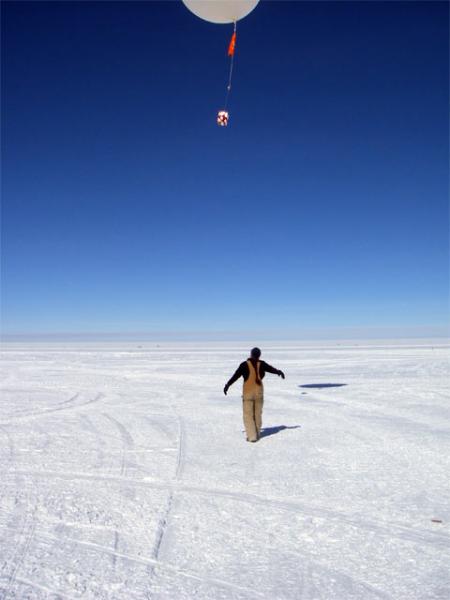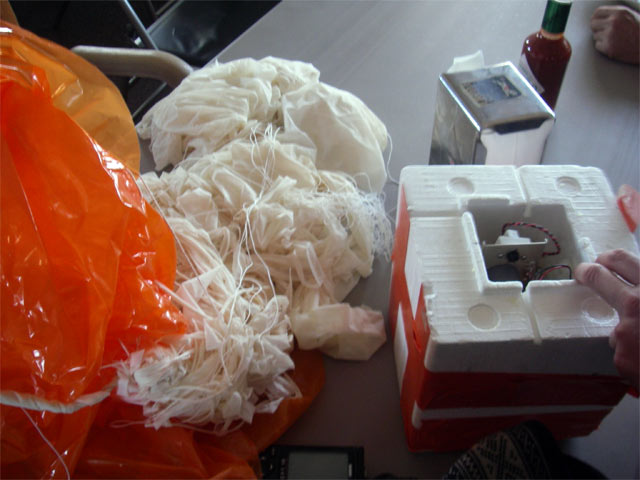( Log In ) Log In is for TREC Teachers & Researchers only
  |
| Kevin_McMahon |
 Jun 4 2006, 03:50 PM Jun 4 2006, 03:50 PM
Post
#1
|
 Advanced Member    Group: TREC Team Posts: 147 Joined: 12-April 06 Member No.: 25 |
High Temperature: -18 degrees Celsius
Low Temperature: -28 degrees Celsius Launching Balloons Have you heard of the ozone layer? The ozone layer is located high in Earth’s atmosphere and acts as a thin shield to block out a lot of the ultraviolet rays from the sun. Scientists have been afraid that the ozone layer has been going away. If it goes away or gets a hole in it, more ultraviolet light can hit Earth’s surface. My 6th grade students know the effect that ultraviolet light can have on them. 6th graders, if you already have forgotten about ultraviolet light, think about our energy bead experiments to refresh your memory. How do scientists monitor the ozone layer? They ask Katie and Jeff to help. Katie and Jeff are Summit’s science technicians. Every Friday, Katie and Jeff launch a balloon carrying sensitive instruments. The balloon soars into the air at about 5 meters per second. As the balloon rises, the instruments record data about air temperature, the ozone level, and the altitude of the balloon. The instrument box sends this data to Katie and Jeff’s computer. This information is then sent to a scientist studying the ozone levels in the atmosphere. I was fortunate to be able to help Katie and Jeff attach the instrument box to the balloon.  Mr. McMahon holds the instrument box while Jeff attaches it to the balloon.  After the box was attached, Katie took three steps back and launched the balloon. It quickly soared into the air. On this launch day, the sky was so clear that we could still see the balloon when it was 20 kilometers (12.4 miles) in the air. Once the balloon reaches an altitude of 30 – 40 kilometers, the balloon will pop. As the instrument box falls back to Earth, a small orange parachute opens up to slow its descent. The instruments continue to record data on the way back to Earth. These balloons usually travel very far away and the scientists are not able to retrieve them. However, our launch day was an unusual day because there was little to no wind at Summit. Katie and Jeff thought they could find the fallen balloon. They hopped on a snowmobile and headed 26 kilometers outside of our camp. Amazingly, they found it just where they predicted. Way to go, Katie and Jeff, for finding the weather balloon and instrument box. The instrument box can now be used again. Sadly, the balloon cannot be reused. Do you want to see what a popped balloon looks like?  The popped balloon and instrument box that were recovered on the ice sheet. Katie and Jeff are not the only people launching these balloons. Scientists all over the world launch these balloons. By sharing the information collected, scientists are getting a better idea about the health of Earth’s thin shield of protection from ultraviolet light. To learn more about the ozone layer and what humans are doing to help repair it, visit the following web sites: EPA Kids Ozone Web Site, http://www.epa.gov/sunwise/kids/kids_ozone.html EPA Ozone Comic Book, http://www.epa.gov/ozone/science/missoz/index.html Arctic Fact of the Day: The sparse population of Greenland is confined to small settlements along coast, but close to one-quarter of the population lives in the capital, Nuuk. |
| Amy_Clapp |
 Jun 7 2006, 01:25 AM Jun 7 2006, 01:25 AM
Post
#2
|
 TREC Teacher    Group: TREC Team Posts: 84 Joined: 27-April 05 Member No.: 6 |
Dear Kevin,
Your journal entries are great! I have throughly enjoyed reading them. I am a fourth, fifth,and sixth grade science teacher and I can't wait to use some of what you have written in the classroom next year! The links you've used are great too! I participated in TREC expeditions for the last two years and it seems to me that you are enjoying it and learning as much as I did! I have a couple of questions for you....first of all, I just found out that I am going to be visiting the Summit Station in the second week of July...I would love to know about some of the research that might be going on there now that will still be happening in July. If you do know of any projects that will be continuing on through, I would love it if you could tell me about them (when you have a spare moment...even if it is when you return). Also, I would love to get any tips that you have to give for someone who is going to Summit. I was also wondering what you though Summit was going to be like and how your experience has been the different from what you expected. I will keep checking in on your adventures... Amy Clapp Salisbury Community School Salisbury, VT |
| Kevin_McMahon |
 Jun 8 2006, 02:09 PM Jun 8 2006, 02:09 PM
Post
#3
|
 Advanced Member    Group: TREC Team Posts: 147 Joined: 12-April 06 Member No.: 25 |
Hi Amy,
You are in for a treat. You will love Summit. There will be plenty of research going on at Summit while you are there. Gayle Hagler, from Georgia Tech, will still be there gathering air and snow samples in order to determine what types of particles are in the air and snow. The folks from ICDS (Ice Core Drilling Services) will continue to test their newest ice core drill. Although the drill will be used in Antarctica, they are testing it in Greenland and hope to drill to a depth of 700 meters by August. New researchers come and go with each flight. Some of the researchers that were taking ice core samples or studying the firn air movement have left but there will certainly be a lot of activity. The science technicans will also have their regular workload. They are the people who launch the balloons (usually on Friday) and measure snow accumulation in the "bamboo forest". I wasn't sure how my body would react to the cold of Summit. I was pleasantly surprised about how comfortable I was there. I would typically wear three layers of clothing (thermal underwear, a fleece layer, and then a parka and an insulated bibb). Sometimes I could walk around without the parka or the bibb because the weather seemed like it was warming up to me. However, I always kept the parka and the bibb nearby in case I needed them. Veco Polar Resources did a great job giving me the right clothes and the right sleeping kit. I also wasn't sure how my camera and laptop would work. They worked fine. The Big House is a heated structure so I kept most of my electronic stuff in the Big House. When I was outside, I kept the camera in an inside pocket of my parka. I am in Kangerlussauq right now and will return to the States on June 10. I am sure you will travel through "Kanger". Bring a lightweight longsleeve shirt for Kanger because the arctic mosquitoes are in full force now. E-mail me next week at ktmcmahon@earthlink.net and we can talk further about Summit and what to bring. I think you will really enjoy it. Kevin |
  |
1 User(s) are reading this topic (1 Guests and 0 Anonymous Users)
0 Members:

|
NSF Acknowledgment & Disclaimer | Time is now: 19th November 2024 - 09:52 AM |
Invision Power Board
v2.1.7 © 2024 IPS, Inc.








